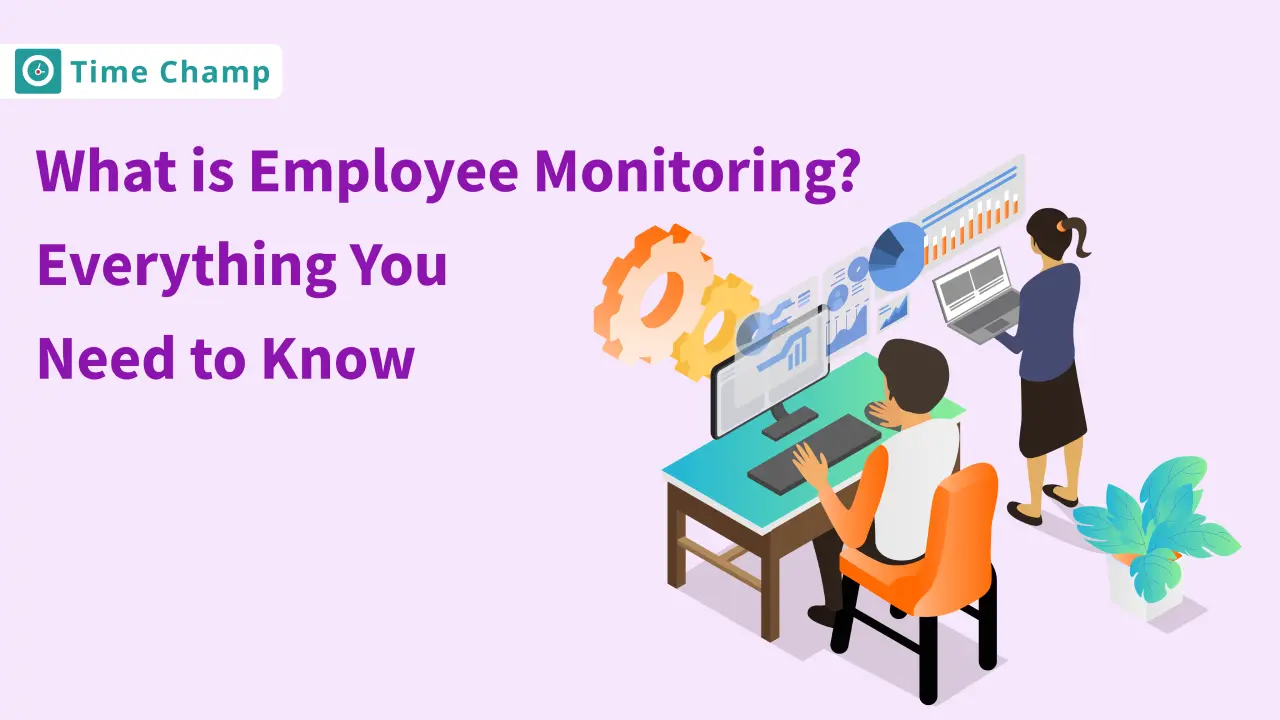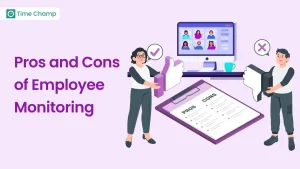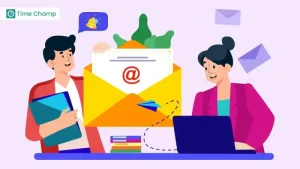Employee monitoring is a method used by businesses to track the performance and activities of their employees. Employee monitoring is gaining attention as an important tool for businesses. It’s not just about keeping an eye on employees; it’s about improving the productivity, security, and efficiency of employees.
In this blog we will cover the basics of employee monitoring, exploring its types, benefits, and challenges, and how to choose the right software. We will also give some tips to implement and use the data collected to create a more transparent and efficient workplace.
What is Employee Monitoring?
Employee monitoring refers to tracking employee activity during their work hours. The primary goal of monitoring employees is to improve workplace efficiency and productivity. It helps managers to understand how employees are spending their time, identify any problems in workflow, and ensure that resources are used efficiently. Additionally, it’s a valuable tool for protecting company assets and information, preventing inappropriate or unsafe behavior, and meeting legal as well as regulatory demands.
With the advancement of technology, this practice has evolved beyond simple surveillance. It now includes various forms of tracking, from computer usage and internet access to emails and physical location.
In modern workplaces, where remote working is becoming more common, employee monitoring also plays a crucial role in maintaining team cohesion and ensuring that everyone is on the same page, irrespective of their physical location. By offering insights into employee activities, it helps businesses make more informed decisions that could result in better performance and success.
Types of Employee Monitoring
MonitoringComputer Activities
Monitoring computer activities refers to the process of monitoring how employees use their computers and laptops provided by the company. Computer monitoring tracks which applications and programs employees use, how long they use them, and how productive they are while working. It helps managers identify if employees are spending time on work-related tasks or getting distracted by non-work-related activities. This information is essential for understanding how work time is spent and where improvements can be made.
Apps and Websites Usage
This type of monitoring focuses on the apps and websites that employees use during working hours. Employees should not use work time to visit non-work-related or potentially risky websites. Monitoring apps and websites used allow employees to stay focused, productive, and protected in the office. It also helps to block access to inappropriate content and ensures that the company is not exposed to potential legal issues or security breaches that may arise from unprofessional practices while online.
Keystroke logging
Keylogging records every keystroke made on a computer. In security applications, this technology is frequently used in detecting unauthorized access or data breaches. However, it poses major privacy issues as it can gather personal information. Employers that use keystroke logging will have to find the right balance between security and respect for the privacy rights of their workers. It’s important to use this method responsibly and ensure employees are aware of its implementation.
Network and Email
Network and email monitoring involves monitoring all network activity and email communications within the organization. This form of monitoring is critical for maintaining operational security and ensuring that communication is appropriate and task-related. It helps in avoiding data leaks, protecting confidential information, and that the company’s resources are used for professional purposes. Monitoring email traffic and network usage allows companies to identify and resolve potential security threats promptly.
Tracking Employee Telephone Calls
Telephone Monitoring is popular, especially among those who work face-to-face with customers. It tracks phone activity including call length, frequency, and the content of the call. This type of monitoring is vital in ensuring quality customer service, ensuring the accuracy of information passed over calls, and improving the efficiency of telecommunication. It is also used for training so that managers can give feedback based on actual call interactions. This form of monitoring needs to be well-balanced and balanced with respect for personal conversations and privacy considerations.
Employee GPS Tracking
Employee GPS tracking is primarily used for roles that involve travel or fieldwork. It involves tracking an employee’s geographical locations to ensure that they are at their assigned work sites and managing their travel efficiently GPS tracking helps with logistics planning, employees’ safety, and time spent in different locations verifying. It improves the transparency at field operations and can play a significant role in the effective coordination of mobile workforces.
But wait, there’s more! Let’s uncover the advantages of employee monitoring.
Advantages of Employee Monitoring
Effective Management
Employee monitoring is very important for effective management. It helps managers to gain insight into how employees spend their work hours allowing for the identification of inefficiencies and areas that need to be improved. This information helps for better allocation of work and resources, ensuring that the teams are productive and deadlines are properly met. Employee tracking also can highlight employees’ skills and areas where they need more training or help. Therefore, it contributes to establishing a more structured and well-managed environment, leading to higher productivity and better overall performance.
Uncover Unrealized Revenue from a Fully Engaged Team
Employee monitoring can uncover hidden potential within a team. By monitoring work patterns and productivity, companies can identify unutilized or underutilized resources or skills in their workforce. With this insight, managers can reallocate work much more efficiently so that everyone is involved and will give the best of their abilities. A fully committed team not only works more productively but also tends to be more innovative and motivated. This can result in the discovery of new sources of income streams and product quality, ultimately contributing to the business’s financial growth.
Company Financial Growth
One of the primary benefits of effective employee activity monitoring is financial growth. By increasing productivity and efficiency, businesses can accomplish more in less time, leading to cost savings and potentially higher revenue Monitoring also prevents time theft and ensures that company resources are used for their intended purposes. Additionally, it can offer data to make informed decisions about resource allocation, hiring, and training, which can further enhance financial efficiency. These factors can help a lot in making a bottom line for a company in a competitive business environment.
Safety and Security
Employee tracking helps to ensure the security and safety of both employees and the organization. By monitoring employee activities, companies can prevent unauthorized access to confidential information and safeguard themselves from data breaches. In businesses where employee safety is a concern, monitoring can ensure that safety protocols are followed. Additionally, in the case of remote or field workers, GPS tracking can be vital in ensuring employee safety in case of emergencies. This aspect of monitoring is especially important in today’s digital environment, where information security and employee well-being are top priorities.
Compliance and Accountability
Monitoring helps in maintaining compliance with legal and regulatory standards. By monitoring work hours, breaks, and overtime, companies can stay complying with labor laws. It also helps organizations maintain proper records for auditing purposes. Moreover, monitoring of employees fosters a culture of accountability in the workplace. When employees are aware that their performance is being monitored, it motivates them to stay focused and strive for excellence in their work.
Enhanced Employee Engagement and Satisfaction
Contrary to popular belief, employee tracking, when done transparently and respectfully, can enhance employee engagement and satisfaction. It gives a ground for identifying and rewarding top performers, thus motivating employees. Monitoring can also help identify who is overburdened with work and managers can then redistribute workloads more fairly, preventing burnout and improving job satisfaction. Moreover, employees who understand that monitoring is focused on making the workplace better instead of just spying on them, are more likely to see it positively.
However, while employee monitoring has its benefits, it’s important to consider the other side of the coin. Let’s explore some of the potential disadvantages that come with monitoring employees.
Disadvantages of Employee Monitoring and How to Address Them
Employee Privacy
Invasion of privacy is one of the primary causes of worry in employee monitoring. Monitoring can make employees feel that they are being watched all the time, which may create uncomfortable feelings and distrust. To address this, transparency is important. Employers should clearly explain what is being monitored and why. By ensuring that the monitoring is only for work-related activities and not for personal surveillance the organization can maintain the balance between the company’s interests and the privacy of the employee.
Trust Issues
Intensive monitoring could indicate a lack of mutual trust between employer and employee. To overcome this, monitoring data should be used constructively, concentrating on support and betterment, rather than punishment. Employers can maintain trust by building a culture where monitoring is seen as a tool for growth not just oversight.
Increased Stress Level
Constant monitoring can be a high-pressure environment, with excessive stress and anxiety for workers. Employers must ensure that the goals established are realistic and considerate of the employees’ well-being. Monitoring stress can be reduced by offering support, recognizing good work, and promoting taking breaks.
Legal Concerns
If the monitoring of employees is not done properly, it may lead to legal issues. It is essential to know well and follow privacy laws and regulations. Employers should get legal advice to ensure that their monitoring practices are legal and respectful of employees’ rights. Transparency and getting consent as needed are also important elements in dealing with legal issues.
Decreased Morale and Creativity
Excess monitoring can hinder creativity and decrease morale as employees may believe they are not trusted to work independently. It is important to maintain a balance between offering employees autonomy and allowing for creative thinking. Recognizing and rewarding innovative ideas and achievements can help improve morale.
Resistance to Monitoring
Employees may oppose monitoring, particularly if they believe it is unfair or invasive. To solve this, involve employees in the decision-making process about monitoring processes. Listen to their thoughts and make adjustments as needed to ensure that the monitoring system is fair and acceptable to everyone.
Potential Misuse of Data
There is always the possibility that the information gathered through monitoring could be exploited or misused. To prevent this, it is necessary to have strict rules concerning who has access to the monitoring data, and how this data is used. It is important to ensure that the data is used only to improve business operations and not for any form of discrimination.
Also Read: Pros and Cons of Employee Monitoring
Legal Considerations for Employee Monitoring
When implementing employee monitoring, it’s important to consider legal implications. This includes knowing laws regulating privacy, employment, and data protection. Employers should consider questions such as:
- What level of monitoring is legally permitted?
- How can employees’ consent be obtained?
- Are there limitations on the types of data that can be collected?
Following legal guidelines not only ensures compliance but also helps in building trust with employees.
Ah, the million-dollar question: Is Employee Monitoring Legal?
Now, let’s address this crucial question in our exploration of legal considerations for employee monitoring.
Is Employee Monitoring Legal?
Employee monitoring is generally legal, but it varies depending on the country and specific state laws. In many jurisdictions, employers are allowed to track employee activities and communications that occur on company property or through company equipment. However, there are often legal requirements to inform employees about the monitoring and in some situations, get their approval.
For instance, email and internet usage monitoring is generally permitted as long as employees are informed. Telephone call monitoring, particularly recording, is subject to strict regulations. In some countries, consent from all call participants may be required.
Usually, GPS tracking will be legal for company-owned vehicles but if the employer continues to track the employees’ movements without a legitimate business reason then it can become a serious problem. Similarly, practices as keylogging and computer monitoring are allowed but, employers should be careful about recording personal data.
Laws also vary with regard to the scope and manner of monitoring. For instance, monitoring for performance evaluation is generally acceptable but monitoring to intimidate or harass employees may result in legal obligations.
The goal is to achieve a balance between the company’s right to protect its interests and the employee’s right to privacy. Employers should have clear policies that specify what is being watched, how the data will be used, and the extent of the monitoring. These policies should be reviewed regularly with legal counsel to ensure compliance with evolving laws and regulations.
Is it Right for the Company?
Deciding whether employee monitoring is right for a company involves ethical considerations beyond legal compliance. It’s about aligning monitoring practices with the values and culture of the company. One should ask oneself whether the benefits from monitoring including increased efficiency and security outweigh the possible negative effects in terms of employee trust and morale.
What are the Company Goals?
- Enhance productivity and efficiency.
- Improve time management.
- Protect sensitive data and intellectual property.
- Ensure compliance with industry regulations.
- Optimize resource allocation.
- Foster a transparent work environment.
- Enhance employee performance through data-driven insights.
- Strengthen security measures against internal and external threats.
- Support remote or hybrid work models effectively.
- Build a culture of accountability and continuous improvement.
Will Employee Monitoring Help Reach These Company Goals?
Employee monitoring can help in achieving these company goals. It helps in enhancing productivity and efficiency by providing detailed information about how employees spend their working hours. This data-driven approach enables better time management and resource allocation, ensuring that employees are working on the right tasks.
Employee tracking software also plays an important role in data security, helping to protect sensitive information. It can alert managers about potential security breaches or unauthorized access, enabling immediate action to protect company assets.
In terms of compliance, monitoring software can help in maintaining regulatory records and ensuring that employees follow industry standards and company policies. This is especially crucial in fields where compliance is heavily regulated.
Employee tracking tools are useful for companies that have adopted remote or hybrid work models because they allow them to retain oversight and coordination of geographically dispersed teams. It ensures that employees are engaged and productive despite the physical distance between them.
Finally, such software promotes a culture of accountability. When employees know their performance is being evaluated using objective data, it motivates them to maintain high standards and encourages continuous personal and professional growth.
How Employee Monitoring Software Helps Businesses Reach Their Goals
Employee monitoring is more than simply supervision; it’s a tool for gathering valuable data that can help a company achieve its goals. The software provides information about daily operations, offering a clear image of how work is done. By understanding the work patterns of employees, managers can identify obstacles, improve processes, and allocate resources more effectively.
This data-driven approach enables companies to improve their productivity and efficiency. For instance, by analyzing time spent on various tasks, managers can identify areas where employees excel and they need additional support or training. This results in more targeted skill development and improved performance management.
Furthermore, an employee monitoring tool can help build a culture of transparency and accountability. Employees who understand that their efforts are recognized and measured are more likely to stay motivated and focused.
In remote work environments, this software bridges the gap between teams, ensuring that everyone remains focused on the company’s goals despite physical distances. It encourages cohesion and a sense of unity among dispersed team members.
Ultimately, employee monitoring software is a strategic instrument that, when utilized properly, can considerably help businesses achieve their goals while also improving overall organizational performance and growth.
Feeling lost in the sea of options? Let’s navigate through the essentials of picking the perfect employee monitoring software that suits your needs.
How to Choose The Best Employee Monitoring Software?
Selecting the right employee monitoring software is crucial for aligning with your company’s unique requirements and culture. Here’s a detailed guide on what to consider:
Develop an Employee Monitoring Checklist
Start by identifying what you need. Do you want to monitor internet use, email, software applications, or other activities by employees? Or more? Consider the size of your workforce, type of work, and compliance requirements. This checklist will serve as a guide for choosing software that will meet your unique monitoring goals.
Time to See Employee Data
Determine how quickly you need to access the monitoring data. Use software that enables real-time monitoring if immediate access to data is vital. Alternatively, solutions that provide daily or weekly reports can be sufficient for less urgent needs. This decision should made based on the operational tempo and immediacy of data application in your management processes.
Customization
The software should be customizable to be suitable for your company’s needs. Setting up monitoring parameters, building customizing reports, and adjusting real-time alerts. Employee monitoring usually does not follow a one-size-fits-all approach, so software that adapts to your unique operational and cultural environment is essential.
Are Experts Needed?
Consider the amount of technical skill that is needed to install and manage the software. Some solutions might need IT specialists to implement them, while others may provide user-friendly interfaces for non-tech-savvy users. Choosing a solution that fits the technical skill level of your team will help avoid implementation obstacles and ensure smooth operation.
Learning Curve
It is important to consider the ease of use and how long it takes your team to adapt to the software. Choose intuitive software with a low learning curve to avoid disruption and ensure quick adoption. This is particularly important if your workforce includes less tech-savvy individuals.
Scalability of system
The selected software should be scalable for your business. This should efficiently handle an increasing number of users and the increasing volume of data without performance problems. Scalability ensures the software remains a valuable tool as your company evolves and increases in size.
Size, Speed, and Storage
Determine how the software will affect your current systems. It should be lightweight that does not slow down the speed of your computers. Also, take its data storage into account, especially if you have many employees or extensive monitoring requirements. Adequate storage and efficient processing are key to effective monitoring.
Integration with Other Systems
The software should integrate seamlessly with other tools and systems you use. Good integration enables effective workflows and data management. Make sure that the software can integrate easily into your current IT infrastructure such as the HR systems, project management tools, or even communication platforms.
Best Practices for Implementing Employee Monitoring in Your Company
It is essential to consider various factors while implementing employee monitoring effectively and ethically. Here are some best practices to follow:
1. Define Clear Objectives
Before implementing monitoring software, define what you aim to achieve. Whether it’s improving work efficiency, ensuring security, or enhancing compliance, having clear objectives helps in choosing the right software and setting appropriate parameters for monitoring.
2. Ensure Legal Compliance
Learn about local and international privacy laws and regulations. Ensure that your monitoring practices are in line with legal standards like GDPR in Europe or privacy laws applicable in your country. Consult with legal experts to ensure full compliance.
3. Maintain Transparency
Be transparent with your employees about the monitoring. Communicate what will be monitored, how the data will be used, and the reasons behind it. Transparency will help to maintain trust and cooperation in your workforce.
4. Prioritize Privacy
Respect employee privacy by limiting monitoring to professional activities. Avoid overly invasive methods and ensure that personal data is not collected or misused.
5. Involve Employees in the Process
Involving your team in the decision-making process can provide valuable insights when implementing monitoring software. Their feedback can help you understand what features are necessary and how the software might impact their day-to-day tasks. Employee involvement also helps in addressing any concerns, dispelling misconceptions, and ensuring the chosen solution is well-received.
6. Set Fair and Reasonable Policies
Establish fair and reasonable policies for monitoring. Make sure that the policies are applied evenly at all levels of the organization to ensure fairness and equality and to prevent discrimination.
7. Use Data Constructively
Utilize data gathered during monitoring to reward good behavior, identify training needs, and enhance efficiency in the workplace. Do not use this data in a punitive manner, or in a way that demoralizes employees.
8. Provide Training and Support
Offer adequate training and support for both managers and employees. Training helps everyone understand how the software works, its benefits, and how to interpret the data it provides.
9. Regularly Review and Update Practices
Review the effectiveness of your employee monitoring practices regularly. Be open to receiving feedback and modifying accordingly, with changing business needs or technological improvements.
10. Focus on Security
Make sure that the monitoring data is securely stored and protected. Implement strong cybersecurity mechanisms to ensure that there is no unauthorized access or data breach.
11. Balance Monitoring with Trust
Monitoring is important but it is also essential to balance it with trust. Avoid creating a culture of constant surveillance that can lead to distrust and anxiety among employees.
12. Emphasize Positive Outcomes
Highlight and communicate the positive outcomes of monitoring, such as improved working conditions, enhanced security, or better resource allocation. This can help employees see the benefits of the system beyond just oversight.
By following these best practices, businesses can implement employee monitoring in a way that is respectful, ethical, and beneficial for both the organization and its employees.
Tips for Monitoring Employees for Enhanced Productivity
After selecting the software, focus on its effective implementation. Train your team, set very clear guidelines about monitoring practices, and make sure communication channels are open so any questions or concerns can be addressed. Regularly review and adjust the monitoring parameters to align with changing business needs and employee feedback.
Be Reasonable
When implementing employee monitoring, it’s necessary to be rational in your actions. Avoid too much monitoring that infringes on your employees’ privacy or makes them feel excessively pressured. Focus on key performance indicators that truly reflect their contribution to work. This balanced approach ensures that monitoring serves its purpose without causing unnecessary stress or discomfort.
Be Flexible with your Expectations
Flexibility is key in monitoring. Understand that different roles may require different levels of oversight and adapt your monitoring practices accordingly. Also, be open to adjusting your expectations based on the insights you gain from the monitoring data. This flexibility can lead to more effective management and a healthier work environment.
Don’t be a Creepy Boss
Respect the privacy and dignity of your employees. Never monitor personal activities and be open about what is being monitored and why. Make sure that your monitoring practices comply with legal requirements and ethical standards. The successful implementation of employee monitoring software needs to establish a culture of trust and respect.
Customize your employee monitoring tool
Customize your monitoring software to match your business requirements. Utilize its customization features to focus on the metrics that matter most to your business. Customization helps to get the required data, without overloading the system with excess information.
Craft an Official Policy
Develop a clear, official policy regarding employee activity monitoring. This policy should outline what is being monitored, how the data will be used, and the rights of the employees regarding their data. Make this policy available to all employees to foster transparency and clarity.
Be Approachable to Your Employees
Encourage open discussion about monitoring software. Be open and receptive to employee concerns and ideas. This free conversation may help to dispel fears and misunderstandings, ensuring a smoother implementation of the monitoring tools.
Conclusion
To conclude, employee monitoring, when implemented thoughtful and ethical manner, can be a powerful tool for businesses. It helps in enhancing productivity, ensuring security, and driving financial growth, while also respecting the privacy and dignity of employees. As you consider integrating employee monitoring into your workplace, remember the importance of balance, transparency, and employee involvement. And if you’re looking for a robust solution, consider trying Time Champ employee monitoring software. It’s a complete employee tracking software designed to help you achieve your business goals while maintaining a positive and productive work environment.
Ready to turbocharge your team’s productivity? Schedule a demo with Time Champ today – your ultimate solution for all-in-one employee monitoring. Discover how we can transform your workplace efficiency!
FAQs on Employee Monitoring
Employee monitoring is the supervision of employees’ work-related actions, which is commonly done utilising technology instruments. It involves tracking internet and email activity, application access, productivity, and, in some cases, location or phone conversations. Its key goals are to increase efficiency, ensure security, and match staff activities with corporate objectives.
Employee monitoring software allows organisations to track and analyse their employees’ work-related activities. It has the ability to monitor internet activity, emails, computer applications, location, and other factors. The major goal is to increase productivity, ensure security, and help manage resources more effectively.
Employees are watched to increase productivity, make better use of time and resources, and safeguard company data. Monitoring also aids in compliance with legal standards and offers information for improved management decisions.
The ideal approach for employee monitoring is to preserve transparency, protect privacy, ensure legal compliance, focus on work-related activities, and use monitoring data constructively for employee development and corporate progress.
Monitoring employee performance entails tracking work activities, productivity, and adherence to organisational standards. This may involve assessing work output, time management, and overall contribution to organisational goals.
Employee monitoring ethics are based on protecting employee privacy, being open about monitoring procedures, and using gathered data ethically. Ethical monitoring prioritises employee well-being while balancing company needs.
Employee monitoring, when done ethically and productively, can help to improve workplace productivity and security. However, if overused, it can be harmful, resulting in privacy invasion and low employee morale.
Companies use a variety of tactics to monitor their employees, including computer activity tracking, email and network monitoring, keylogging, telephone and GPS tracking, and performance metric analysis.
Employee monitoring can boost productivity by exposing inefficiencies, giving data for more effective resource allocation, and fostering a focused work atmosphere. However, it must be done carefully to minimise a detrimental impact on employee morale.
Employee development is tracked by evaluating skill advancement, training completion, performance improvements, and contributions to organisational objectives. Regular reviews and feedback sessions are essential parts of this monitoring.
Employee monitoring can result in increased productivity, better data for decision-making, enhanced security, and regulatory compliance. It can also help to better understand and manage staff dynamics.
A large majority of businesses use some type of employee monitoring, particularly in industries with regulatory compliance requirements or where data security is critical. The actual figure varies by industry and area.
Potential privacy invasions, trust deficits, increased employee stress, and legal challenges if privacy rules are not followed are all problems with employee monitoring. Over-monitoring can also harm morale and creativity, resulting in a counterproductive work atmosphere.







